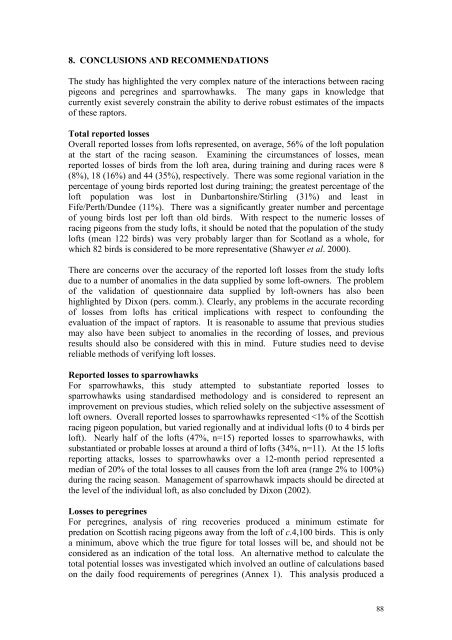RACING PIGEONS â IMPACT OF RAPTOR PREDATION
RACING PIGEONS â IMPACT OF RAPTOR PREDATION
RACING PIGEONS â IMPACT OF RAPTOR PREDATION
You also want an ePaper? Increase the reach of your titles
YUMPU automatically turns print PDFs into web optimized ePapers that Google loves.
8. CONCLUSIONS AND RECOMMENDATIONS<br />
The study has highlighted the very complex nature of the interactions between racing<br />
pigeons and peregrines and sparrowhawks. The many gaps in knowledge that<br />
currently exist severely constrain the ability to derive robust estimates of the impacts<br />
of these raptors.<br />
Total reported losses<br />
Overall reported losses from lofts represented, on average, 56% of the loft population<br />
at the start of the racing season. Examining the circumstances of losses, mean<br />
reported losses of birds from the loft area, during training and during races were 8<br />
(8%), 18 (16%) and 44 (35%), respectively. There was some regional variation in the<br />
percentage of young birds reported lost during training; the greatest percentage of the<br />
loft population was lost in Dunbartonshire/Stirling (31%) and least in<br />
Fife/Perth/Dundee (11%). There was a significantly greater number and percentage<br />
of young birds lost per loft than old birds. With respect to the numeric losses of<br />
racing pigeons from the study lofts, it should be noted that the population of the study<br />
lofts (mean 122 birds) was very probably larger than for Scotland as a whole, for<br />
which 82 birds is considered to be more representative (Shawyer et al. 2000).<br />
There are concerns over the accuracy of the reported loft losses from the study lofts<br />
due to a number of anomalies in the data supplied by some loft-owners. The problem<br />
of the validation of questionnaire data supplied by loft-owners has also been<br />
highlighted by Dixon (pers. comm.). Clearly, any problems in the accurate recording<br />
of losses from lofts has critical implications with respect to confounding the<br />
evaluation of the impact of raptors. It is reasonable to assume that previous studies<br />
may also have been subject to anomalies in the recording of losses, and previous<br />
results should also be considered with this in mind. Future studies need to devise<br />
reliable methods of verifying loft losses.<br />
Reported losses to sparrowhawks<br />
For sparrowhawks, this study attempted to substantiate reported losses to<br />
sparrowhawks using standardised methodology and is considered to represent an<br />
improvement on previous studies, which relied solely on the subjective assessment of<br />
loft owners. Overall reported losses to sparrowhawks represented
















